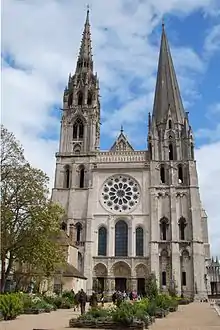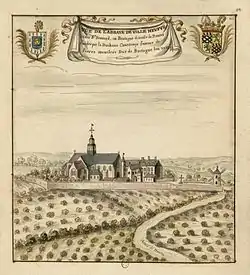Abbaye de Buzay | |
.JPG.webp) The surviving tower of the abbey | |
 Location within Pays de la Loire  Buzay Abbey (France) | |
| Monastery information | |
|---|---|
| Other names | Buzai |
| Order | Cistercian |
| Established | 1134 |
| Mother house | Clairvaux Abbey |
| Diocese | Nantes |
| People | |
| Founder(s) | Bernard of Clairvaux |
| Abbot | See list |
| Site | |
| Location | Rouans, Pays de la Loire, France |
| Coordinates | 47°12′25″N 1°49′32″W / 47.20683°N 1.82549°W |
Buzay Abbey, dedicated to Our Lady, was a Cistercian Abbey at Rouans in Pays de la Loire, France, formerly in Brittany, founded in 1135 and dissolved in 1790.
History

Bernard of Clairvaux founded the abbey at Buzay in 1135, at the request of Ermengarde of Anjou, widow of Alan IV, Duke of Brittany, and mother of Conan III, Duke of Brittany.[1] The next year, in 1136, the first community of a dozen monks settled on the site of the new abbey with Nivard, a younger brother of Bernard de Clairvaux, as their prior.[2][3] Bernard himself came for the dedication of the new foundation, accompanied by Geoffroy de Lèves, Bishop of Chartres, as they were travelling together on a visit to Parthenay to meet William X, Duke of Aquitaine.[4] Around 1143, Bernard of Clairvaux came from Champagne to visit Buzay, but found its abbey in a state of great poverty and neglect. Conan III had not honoured his promises of support, and Bernard asked the monks to return to Clairvaux, but first he met Conan III, who admitted his fault and gave the monks everything he had denied them. They then decided to stay.[3]
The abbey became rich, thanks to the salt trade,[5] commercial traffic on the river Loire, and many gifts of land and other property. In 1177, Robert II, bishop of Nantes, approved the addition of a convent for nuns. In 1180, Geoffrey Plantagenet, Count of Nantes, a son of Henry II of England, Duke of Normandy, and of Eleanor of Aquitaine, assigned to the abbey in perpetuity twenty livres to be paid by the mills of the surrounding parish.[2][3]


With effect from 1474, commendatory abbots were appointed by the duke or king, replacing the regular abbots elected locally.[1]
During the War in the Vendée (March – December 1793), following the French Revolution, Buzay Abbey was destroyed by fire. What now remains of the buildings is a tower which had been rebuilt in the 18th century, and some vaulted cellars. Other survivals are the bells, which were transferred to Chartres cathedral, an Italian marble altar, which was moved to the church of Saint-Louis in Paimbœuf, a pulpit, now in the church of St Peter in Bouguenais, and some other objects, including the oldest crucifix in the Pays de Retz, dating from the fourteenth century, in the chapel of St Anne of Tharon at Saint-Michel-Chef-Chef.[3]
Daughter houses

of 1695
From Buzay, three new Cistercian abbeys were instituted as daughter houses.[3]
On 1 July 1172, Buzay sent a few monks to the small Île du Pilier, north of Noirmoutier. However, the small windswept island posed so many problems for the new community that in 1205 the monks fell back on the island of Noirmoutier and founded the abbey of Our Lady the White.[2]
On 25 March 1200, at the request of Constance, Duchess of Brittany, monks were sent for the founding of her new Villeneuve Abbey,[6] on land belonging to Buzay, located on the Ognon, a river flowing into the lake of Grand-Lieu, near the Châtellenie of Touffou and the village of Bignon. The monks would help to drain the surrounding marshes, with advice from engineers of the Poitevin marshes, and would also help to dig a canal between Messan and the Loire.[2]
In 1259, Buzay was prosperous enough to establish Prières Abbey, at the request of John I, Duke of Brittany, and the Cistercian Order.[2]
List of Abbots

abbot 1552–1564

abbot 1598–1622
.jpg.webp)
Caumartin, abbot 1675–1733

abbot 1733–1737
Regular
- 1144 : Pierre I[1]
- 1150–1153 : Guillaume I[1]
- 1155 : Adam[1]
- 1170 : Pierre II[1]
- 1175 : Geoffroi[1]
- 1177 : Richard[1]
- 1187 : Menno[1]
- 1199 : Guillaume II Robert[1]
- 1203 : Gaultier[1]
- 1206 : Égide I[1]
- 1206 : Raoul[1]
- 1232 : Richard II[1]
- 1236 : Mathieu[1]
- 1237 : Barthélemy[1]
- 1244 : Égide II[1]
- 1268 : Robert[1]
- 1270 : Samson[1]
- 1276 : Daniel[1]
- 1310 : Henri I[1]
- 1317 : Jean I[1]
- 1325 : Jean II de Mez[1]
- 1359 : Henri II[1]
- 1377 : Louis[1]
- 1384 : Guillaume III Maréchal[1]
- 1417 : Jean III Gendron[1]
- 1453 : Pierre Villageys[1]
- 1454–1471 : Humbert Boulay[1]
Commendatory
- 1474–1492 : Odet de la Rivière[1]
- 1492 : Pierre III Gigan[1]
- 1494–1512 : Jean IV Bohier[1]
- 1519 : Jean V[1]
- 1524–1543 : Louis Tissart[1]
- 1552 : Charles, Cardinal of Lorraine[1]
- 1564 : Henri III Clausse[1]
- 1576 : Pierre IV de Gondi[1]
- 1598–1622 : Henri IV Cardinal de Gondi[1]
- 1622–1654 : Jean VI François de Gondi[1]
- 1654–1675 : Jean François Paul de Gondi, Cardinal de Retz[1]
- 1675–1733 : Jean VII François Paul Lefebvre de Caumartin[1]
- 1733–1737 : Louis de Bourbon-Condé, Count of Clermont[1]
- 1737 : Pierre V Augustin Bernardin de Rosset de Fleury[1]
- 1789–1790 : Jean Georges Lefranc de Pompignan[7]
Notes
- 1 2 3 4 5 6 7 8 9 10 11 12 13 14 15 16 17 18 19 20 21 22 23 24 25 26 27 28 29 30 31 32 33 34 35 36 37 38 39 40 41 42 43 Pierre-Hyacinthe Morice, Histoire ecclesiastique et civile de Bretagne (1756), p. cxxxix (in French)
- 1 2 3 4 5 Arlette Lebigre, “Les débuts de l’abbaye cistercienne de Buzay en pays de Rais, 1144-1250”, in Revue historique de droit français et étranger, Issue 3, July–September 1967, pp. 451-482 JSTOR 43848255 (in French)
- 1 2 3 4 5 Abbaye de Buzay at infobretagne.com, accessed 27 April 2020
- ↑ Anatole Bordot, Littérature française, Origines (1866), p. 121
- ↑ A. R. Bridbury, England and the Salt Trade in the Later Middle Ages (Clarendon Press, 1955), p. 71
- ↑ Morice (1756), pp. cliii–cliv (in French)
- ↑ Ulysse Chevalier, Notice chronologico-historique sur les archevêques de Vienne (1879), p. 18: “Jean VII Georges Le Franc de Pompignan, évêque du Puy, lui succéda... il se démit alors de son siége et reçut l'abbaye de Buzay; il mourut le 29 décembre 1790”
Links
- LA TOUR DE BUZAY at pornic.com